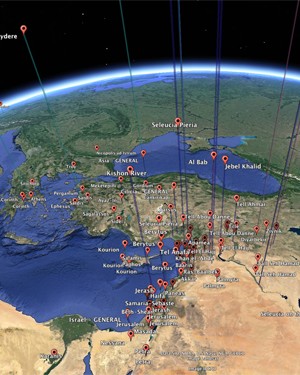
Money Talks When Ancient Antioch Meets Google Earth
There's a map of an ancient Syrian trade route that shows how one city's political sway extended farther than once thought.
This map isn't a time-worn and mysterious etching on a stone tablet. Turns out it's easily found on a different type of tablet the kind with apps.
With the swipe of a finger, the University of Cincinnati's Kristina Neumann can
zoom along the boundaries of ancient Antioch during the beginning of Roman takeover thanks to the modern cartography of Google Earth software
. The simplicity with which she flicks across the Middle Eastern landscape belies the depth of information available at her fingertips and the effort that's gone into her research.
"I trace the process of change by working with historical proxies, in this case coins," says Neumann, a doctoral candidate in the McMicken College of Arts & Sciences Department of Classics. "I created my own database from previously published excavation reports and lists of coin hoards, and imported it to Google Earth. My criteria are so detailed that I can see all the coins for a particular emperor or of a particular material."
She hopes this visual, interactive way of presenting the ancient world
inspires other historians to get more creative in today's "there's an app for that" world
.
"I'm trying to help historians think outside the box," Neumann says. "There's a huge movement in the digital humanities in general, and this research speaks to that. Using tools such as Google Earth to visualize the ancient world could also have ramifications for how we look at data today."
Neumann will present her research "
Using Google Earth to Visualize an Ancient Citys Influence: Roman Antioch
" at the
Archaeological Institute of America
and
American Philological Association
Joint Annual Meeting to be held Jan. 2-5 in Chicago. The meeting attracts more than 3,000 international attendees to share news and ideas among the top archaeological and classical scholars.
In ancient times, much like now, authorities determined which foreign currency was accepted in a community. For Neumann, this made coins an ideal representation of a political relationship among cities. For example, if lots of Antiochene coins were discovered in a neighboring city, it's likely a political agreement existed between the two governments.
Coins were also a data-rich resource for Neumann. In addition to tracking where the coins were found, she cataloged critical information about a coin such as when it was minted and under whose authority it was made that has been derived from the images and inscriptions imprinted on it. Other artifacts, like pottery, were less likely to have such identifiers.
Neumann uses Google Earth to convert the vast information in her coin database into a visual representation of Antioch's political borders.
She analyzes how the software plots which coins were found where and in what quantity across different historic time periods. This way she can follow the transformation of Antioch's political influence as it was absorbed by the Roman empire.
She has found Antiochs civic coins were spread farther out than previously theorized, and they were particularly abundant along a known trade route. Neumann can scan centuries of change in seconds with Google Earth to show the overall contraction of Antioch's political authority but also its continued and evolving influence in selected regions and cities and eventually its greater integration within the empire.

A Google Earth map created by Kristina Neumann
"I'm very interested in the idea of empire physical empires, but also empires similar to what America has with its cultural and informational empires, and the idea of globalization," Neumann says. "My bigger question is, '
How do you get one empire which absorbs a lot of different people and yet lasts so long? How is stability achieved even with vast diversity?' I think that can speak to today's society with the culture changes we're seeing
."
Neumann's high-tech spin on ancient history supports the
by producing new ways of understanding and transforming the world through research and scholarship. Neumann has been assisted in her research by her adviser, associate professor Barbara Burrell, and senior research associate John Wallrodt. Funding for Neumann's research was partially provided through the
' Louise Taft Semple Fellowship.
Related Stories
UC grad takes liberal arts path to study medicine at Johns...
April 9, 2025
A career in healthcare has numerous different pathways and not each one is the same. Some students choose the traditional track, while others try a different approach to success. Jordan “Mint” Sewell can attest to this.
President Pinto announces interim provost
April 8, 2025
UC President Neville Pinto announced that Dr. John Weidner, dean of the College of Engineering and Applied Science, will step in as interim provost following Dr. Kristi Nelson's departure on June 1.
Prehistoric rhinos lived in mega-herds
April 8, 2025
Rhinos that flourished across much of North America 12 million years ago gathered in huge herds, according to a new study by the University of Cincinnati.
